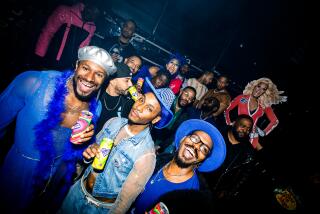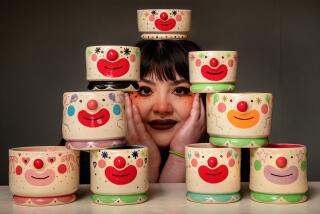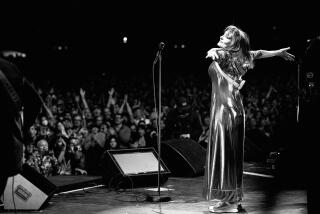POP MUSIC REVIEW : Siouxsie Sioux and Creatures at the Wiltern
- Share via
Siouxsie Sioux (as in Suzy Sue) dominates female post-punk female fashion and consciousness the way Jacqueline Kennedy defined straight style in the ‘60s. There’s nobody close.
On Thursday, the lobby of the Wiltern Theatre swarmed with fans paying homage to the singer of Siouxsie & the Banshees: specters in black lace, faces powdered white, eyebrows painted thick, dark-circled eyes, black lips, helmets of ratted hair.
Same for the girls. It was like an Elvis impersonators’ convention, but with Siouxsie rather than Presley as the central icon.
The occasion wasn’t a Siouxsie & the Banshees concert. The band has become one of the few punk-era originals to survive and thrive more than a decade later, and it now headlines bigger rooms than the 2,300-seat Wiltern. Instead, It was the first local appearance by the Creatures, a side project consisting of Sioux on vocals and Banshees drummer Budgie on percussion. That--and a fair amount of programmed sounds--was it. (They also play Crawford Hall at UC Irvine tonight.)
At first it seemed like a thin premise for a whole show, despite the intriguing nature of some of the material on the Creatures’ recent album “Boomerang”: a batch of rhythm-centered songs from a dimly-lit singer with a strong but expressively limited voice and a haughty personality. By the end the music had made its point, and the once-severe Siouxsie was grinning and joking like a schoolgirl.
The set took its initial momentum from the Siouxsie worship, from the release of anticipation, from the audience’s sense of partaking in a special event. Siouxsie and Budgie quickly picked up and intensified that energy, and the opening sequence found the crowd rising and falling with her every leap, swaying with every undulation, hanging on every wail.
Siouxsie, done up in tie-dyed, Gypsy-cum-Middle-Eastern finery, performed with the exaggerated gestures of a silent-film actress, her face drawn in codified expressions of anxiety, her eyes widening and flashing as each new song took hold.
The show tended to lose focus periodically, since the lyrics were pretty indecipherable and the musical vocabulary so limited. Instead of expanding the range, the programmed music--from horn riffs to full rock band--diluted the premise, making things sound more conventional without providing the rewards of a live performance.
The best moments were the barest: Siouxsie wailing, Budgie pounding. There they caught a pure, primitive power, a purging sense of ritual underscored by Siouxsie’s animal yelps, barks and howls. It was by firelight at the dawn of time, not a computer in the universe.
Second-billed Blackbird is also a duo: L.A. boys Chip and Tony Kinman, who set up a programmed drum pattern and layered on the bass and guitar. It never stopped, just shifted gears up and down, and came off like the Jesus and Mary Chain meets the Beatles, Beach Boys and Merle Haggard. Unrelenting and compelling.
More to Read
The biggest entertainment stories
Get our big stories about Hollywood, film, television, music, arts, culture and more right in your inbox as soon as they publish.
You may occasionally receive promotional content from the Los Angeles Times.










